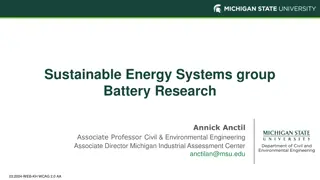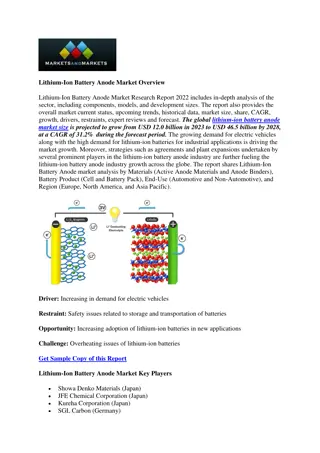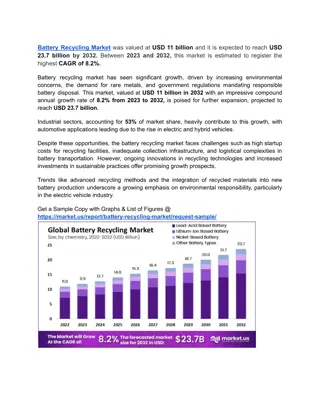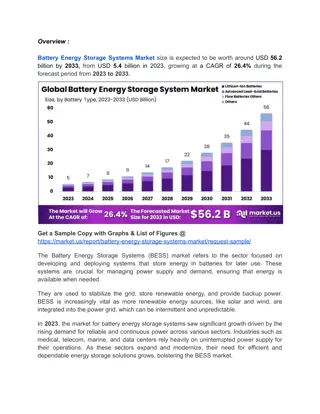Comparative Battery
Thorough analysis of battery performance under varying environmental conditions by simulating temperature differences. Examining non-rechargeable and rechargeable battery types to measure capacity, life span, voltage, and current output.
Download Presentation

Please find below an Image/Link to download the presentation.
The content on the website is provided AS IS for your information and personal use only. It may not be sold, licensed, or shared on other websites without obtaining consent from the author.If you encounter any issues during the download, it is possible that the publisher has removed the file from their server.
You are allowed to download the files provided on this website for personal or commercial use, subject to the condition that they are used lawfully. All files are the property of their respective owners.
The content on the website is provided AS IS for your information and personal use only. It may not be sold, licensed, or shared on other websites without obtaining consent from the author.
E N D
Presentation Transcript
Comparative Battery Performance Analysis for Various Environmental Conditions Shawn Wang and Barry Gu Webber Academy
Abstract While non-renewable energy is still far from irrelevant, a thorough understanding of batteries and electrical energy is becoming increasingly important in the design and application to best suit consumer needs. In this study, in order to comprehend the effect of environmental factors on batteries, we utilized the variation of temperature to simulate battery use under various climaticconditions.
Background How a battery functions Effects of environmental factors on batteries Types of batteries Non-Rechargeable -Only a certain amount of electrons available, and cannot be replenished - Alkaline - Coin cell - Lithium ion Rechargeable -In these batteries there are reverse cell reactions that allow for the battery to recharge - Lead-acid - Ni-Cd - Ni-MH - Lithium Variables to measure battery performance: Battery capacity Battery life Voltage Current
Methodology Materials Batteries Battery cartridges Multimeters Stopwatch (Smartphone) Electrical motors Electrical wires Water Plastic bags Sous Vide (high temperature) Freezer (low temperature) 1.2 V AA Rechargeable Battery 1.5 V AA Non-rechargeable (Alkaline) battery
Methodology (contd) Experiment Set up 1. High temperature (20 C , 50 C ) -use sous vide to control and maintain water bath temperature Low temperature (-18 C ) -ensure that freezer is regulated to targeted temperature Connect the battery cartridge to the motor using electrical wires, and insert batteries into the cartridge Place batteries in plastic bag, seal, and submerge it into water bath Procedure 1. Measure battery voltage every 20 mins I. Disconnect circuit II. Remove battery from cartridge III. Measure all batteries for voltage using a multimeter 2. When motor stops running, record time 2. 20 C , 50 C 3. 4. -18 C
Observations and Data Analysis Figure 1. Battery Voltage Changes under Different Temperatures (20 C, 50 C, and -18 C)
Observations and Data Analysis (contd) Figure 2. Battery Life Comparison under Different Temperature (20 C, 50 C, and -18 C)
Conclusions Batteriesat-18 C have thelongest batterylife in ourstudy. Batteries at 20 C and 50 C have similar battery lives. This likely is due to the temperature difference was not significant enough, indicating that, above room temperature environment, battery life can be fairly constant withincertaintemperaturerange. Non-rechargeable batteries appear to have a longer battery life than rechargeable batteries. It should be noted that the tested non-rechargeable batteries have a higher manufacture voltage (1.5 V) than the rechargeable batteries(1.2V). It appears that for rechargeable battery tests , as approaching the end of the battery life, the voltage rapidly drops, while non-rechargeable batteries had a drop in voltage near the beginning of the test, and remained constantuntilthe endof thebatterylife. Sourceof errors: Temperaturechangesas batteriesbeingtakenintoroomtemperatureenvironmentformeasurements Multimetererrors Motorqualities Thoughtson futurestudy moisture, dramaticandsharpchange of temperature
Applications Achieving conditions Utilization and design for household application using different types of batteries Utilization and design for industrial applications using different types of batteries to meet performance and cost-savingrequirements optimal battery performance under various weather
Acknowledgement Webber Academy Ms. Grelowski Shawn's parents -Ling Yang and Xu Wang Barry s father -Yong Gu
Experiment Data_ 20C Battery B @ 20 C Battery A @ 20 C Time Rechargeable Non-rechargeable Time Minutes 0 20 40 60 Rechargeable Volts 1.295 1.242 1.224 1.184 Non-rechargeable Volts 1.591 1.336 1.288 1.276 Minutes Volts Volts 0 1.292 1.593 20 1.241 1.33 40 1.221 1.286 60 1.18 1.272 80 0.996 80 0.934
Experiment Data_ 50C Battery B @ 50 C Battery A @ 50 C Time Rechargeable Non-rechargeable Time Minutes 0 20 40 60 80 Rechargeable Volts 1.295 1.263 1.255 1.232 0.983 Non-rechargeable Volts 1.593 1.39 1.329 1.299 1.281 Minutes Volts Volts 0 1.291 1.591 20 1.261 1.384 40 1.255 1.322 60 1.227 1.29 80 1.009 1.273 100 1.273 100 1.265
Experiment Data_ -18C Battery A @ -18 C Rechargeable Volts 1.301 1.252 1.211 1.186 1.072 0.851 Battery B @ -18 C Rechargeable Volts 1.295 1.252 1.207 1.19 1.081 0.83 Time Minutes 0 20 40 60 100 120 Non-rechargeable Volts 1.497 1.421 1.372 1.321 1.271 1.212 Time Minutes 0 20 40 60 100 120 Non-rechargeable Volts 1.505 1.384 1.322 1.29 1.273 1.265 140 1.145 140 1.152 160 1.112 160 1.121
Battery Life vs. Temperature Battery Life Temperature Rechargeable Non-rechargeable C Minutes Minutes -18 102.2 136.1 20 76.7 54.4 50 83.2 98.9























